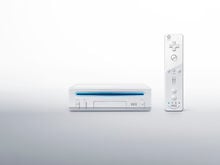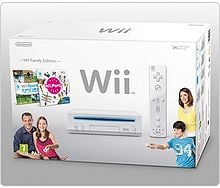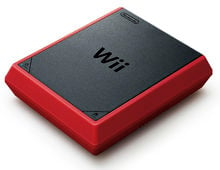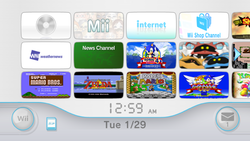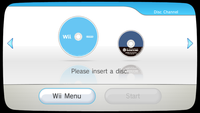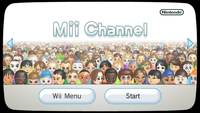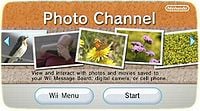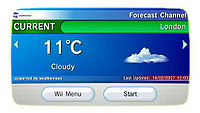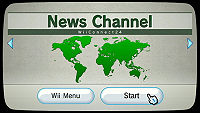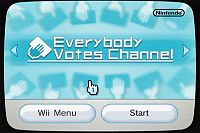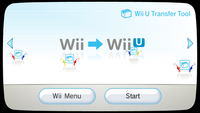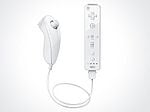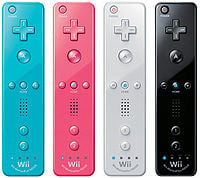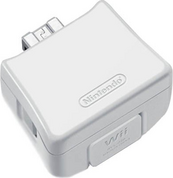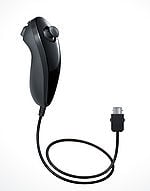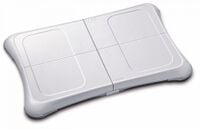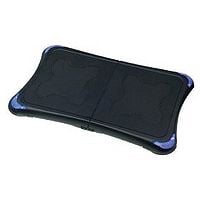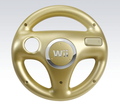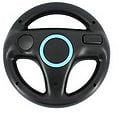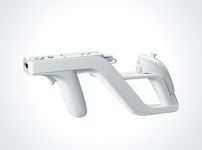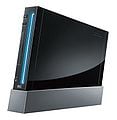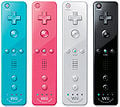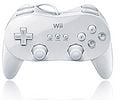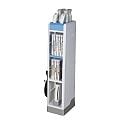Wii
The Wii (ウィー, Wī) is a Nintendo video game console that was released on November 19, 2006 in the United States for $250.00. It was then released in Japan on December 2, 2006, Australia on December 7, 2006, and Europe on December 8, 2006. In every country except Japan, Wii Sports is included with the Wii. For Wii Sports, in a conference, Shigeru Miyamoto explained how when they were creating the baseball game, they originally had Mario characters rather than the Mii characters, but soon decided to change it. The Wii came with 30 titles at its launch. Before the official name was announced on April 27, 2006 the console was codenamed Revolution. The Wii has backwards compatibility with the Nintendo GameCube, meaning GameCube games can be inserted into the disc slot and can be played on the Wii. This makes it the first home Nintendo console to provide official backwards compatibility with its predecessor.
Unlike the Nintendo GameCube, Wii game discs use the standard DVD size, which enables them to hold more memory than the GameCube discs: up to 4.37 GB (4,699,979,776 bytes) for single-layered discs, and up to 7.92 GB (8,511,160,320 bytes) for dual layered discs. As more games are being released on the Wii, more games that utilize Nintendo Wi-Fi Connection have been made. This allows players to interact with other players around the world in games. The first game in the North American region to do so was Pokémon Battle Revolution on June 25, 2007.
The Wii sold 100 million units as of December 31, 2013Template:Refneeded, making it Nintendo's best selling home console.
The Wii U was announced at E3 2011 and succeeded the Wii in 2012. It can still play Wii games and controllers with backwards compatibility.
Since May 20th 2014, online play for many Wii games has been terminated because the Nintendo Wi-Fi Connection service has discontinued.[1]
Models
Wii Family Edition
This revision of the Wii was announced on August 17, 2011. This model is designed to only sit horizontally (with the buttons changed accordingly) and is incompatible with the Nintendo GameCube's software and its accessories. This model was released in Europe on October 7, 2011 and in Australia in late October 2011[2] in order to replace the older model and stop its production. North America launched the Wii Family edition on October 23, 2011 in a promotional pack that includes a black console, the game New Super Mario Bros. Wii and the Super Mario Galaxy: Original Soundtrack. The Wii Family Edition's release in North America was not originally intended to replace the older revision of the Wii.[3]
Wii Mini
This revision was announced on November 27, 2012. As its name suggests, the Wii Mini is the smallest model of the Wii, and shares several features with the Wii Family Edition such as the incompatibility to play Nintendo Gamecube and its accessories. It also does not have online features and several built in software, such as the Photo Channel and the Weather Channel, similar to the Wii Mode on the Wii U. It also can only sit horizontally. The main feature is its notable redesign. Unlike the original Wii or the Wii Family Edition that are mostly white, the Wii Mini is black with a red framing. All the buttons are located on the top of the console and lacks online support for Wii games. Additionally, the Wii Mini has a manually operated top-loading disc drive (similar to the GameCube) instead of the slots that former models have. The console launched in Canada on December 7, 2012 for $99.99[4]. It was then released in Europe on March 22, 2013 at a cost of at least £79.99[5]. It was launched in the United States on November 17, 2013 bundled with a red Wii Remote Plus and a red Nunchuk for $99.99[6].
Games
None of these games were available at launch. Super Paper Mario was the first traditional Mario game on the system and launched on April 9, 2007 in the United States. WarioWare: Smooth Moves, however, preceded it, coming out on December 2, 2006 in Japan, January 12, 2007 in Europe, January 15, 2007 in the United States, and January 25, 2007 in Australia. However, the first traditional Mario game released in the PAL Region was Mario Strikers Charged.
In order of first release:
- WarioWare: Smooth Moves
- Super Paper Mario
- Mario Strikers Charged
- Mario Party 8
- Donkey Kong Barrel Blast
- Super Mario Galaxy
- Mario & Sonic at the Olympic Games
- Super Smash Bros. Brawl
- Dr. Mario Online Rx (WiiWare)
- Mario Kart Wii
- Mario Super Sluggers
- Wario Land: Shake It!
- Donkey Kong Jungle Beat (part of the New Play Control! series)
- Mario Power Tennis (part of the New Play Control! series)
- WarioWare: D.I.Y. Showcase (WiiWare)
- Mario & Sonic at the Olympic Winter Games
- New Super Mario Bros. Wii
- Super Mario Galaxy 2
- Super Mario All-Stars Limited Edition
- Donkey Kong Country Returns
- Mario Sports Mix
- Mario & Sonic at the London 2012 Olympic Games
- Fortune Street
- Mario Party 9
Virtual Console Games
- Main article: Virtual Console
In addition to being backwards-compatible with Nintendo GameCube games, the Wii also possesses a Virtual Console, allowing players to download classic games from the Nintendo 64 era and before to play on the Wii. Each downloaded game costs between 500 and 1000 Wii Points. Games from non-Nintendo consoles can be downloaded as well, such as the Sega Master System or Commodore 64.
Wii Channels
The Wii is Nintnedo's first home console with a wide variety of built-in software. Wii Channels are channels accessible from the Wii main menu. Those are actually "start-up screens" of different "programs" or "channels". There are four pages of channels; each page can hold twelve channels, meaning there can be in total 48 channels in a typical Wii Menu.
Using an SD card in a newer version of the Wii (via updates) makes it possible to use instead of four pages, twenty pages of channels to use, meaning there can be in total 240 channels on an SD card.
On June 27, 2013, the Forecast Channel, News Channel, Everybody Votes Channel, Nintendo Channel, and Check Mii Out Channel services were all discontinued, due to the discontinuation of WiiConnect24.
Disc Channel
The channel in which game discs are loaded and played. It is the first channel on the menu, and displays a preview icon of the game currently inside the disc slot; If a Nintendo GameCube game is in the slot, it does not have a preview, and only displays the GameCube logo. When a disc is loading, as seen in the picture, a Nintendo GameCube disc and a Wii disc are shown spinning, and one of them, depending on which disc-type is currently in the system, then lowers and the preview of the game is shown.
Unlike other channels, the disc channel cannot be moved around into another place on the Wii Menu by holding ![]() +
+ ![]() , but can be moved with use of the Homebrew Channel.
, but can be moved with use of the Homebrew Channel.
Mii Channel
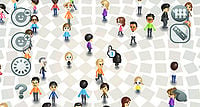
Miis are customized characters that can be used in various Wii games, including games such as Mario Party 8, Mario Kart Wii and the Mario & Sonic games. A maximum of 100 Miis can be created and saved in the Mii Channel in the Mii Plaza. By using WiiConnect24, friends' Miis can be displayed in the Mii Parade: a parade of various Miis saved on friends' Mii Channels. Miis can also be stored in Wii Remotes, with a maximum capacity of 10. These Miis can then be transported to a different Wii by using the Wii Remote on a different Wii and then loading the Miis from the controller.
Photo Channel
The Photo Channel allows the user to not only save and view but apply various effects to photos and videos from either an SD card or the Wii Message Board. Effects include doodling, stamping, and altering brightness settings. Photos can also be turned into sliding puzzles. When the game Mario Kart Wii is beaten, the player is given the choice whether or not to send the winning photo to the Message Board. There are several other games that behave like this such as Super Mario Galaxy, Super Mario Galaxy 2, and Mario Power Tennis.
Wii Shop Channel
The Wii Shop Channel is a virtual shopping network accessible directly via one's Wii system where users can purchase and download WiiWare and Virtual Console games in exchange for the required amount of Wii Points. The Virtual Console allows players to download games that were originally released on the NES, SNES, and Nintendo 64, and play them on their Wii console. They can also buy special games called WiiWare which can be purchased only on the Wii Shop Channel itself. Rather than using money to directly buy the games, a credit currency called Wii Points are used. Wii Points can be earned by either purchasing them with a credit card, or redeeming a Wii Point Card. Other charge-free channels, such as the Nintendo Channel and Internet Channel, are also available for download at the Wii Shop Channel.
When downloading a game or channel from the Wii Shop Channel, one will be asked to verify their purchase (if Wii Points are needed), after which they will be presented with the download screen. The download screen consists of an 8-bit Mario character continuously running across the bottom of the screen and collecting coins as they move towards him. The progress of the download is indicated by three Brick Blocks floating above 8-bit Mario's head, which he will jump up and hit as he runs across the screen every time the download progresses 33%, releasing one coin and turning it into a Used Block. The final Brick Block represents the point at which the download has reached 99%. When 8-bit Mario reaches this block, he will jump and hit it multiple times and continue to do so until the download is complete.
Sometimes, regular 8-bit Mario will instead be Fire Mario. When this happens, one can cause Fire Mario to shoot fireballs across the screen while the download is in progress by holding the Wii Remote sideways and pressing the A button. Occasionally, 8-bit Luigi appears in place of 8-bit Mario, or both 8-bit Mario and 8-bit Luigi will swim across the screen instead of running across it. There are a total of six different animations one may experience while downloading software from the Wii Shop Channel, some of which appear more often than others.
- Wii Shop Channel screenshot.jpg
The current Wii Shop Channel menu.
8-bit Mario appearing on the Wii Shop Channel download screen.
Forecast Channel
The Forecast Channel was added on December 19, 2006, about one month later the console itself was released. The channel preview displays the local weather of where the user is located. The Weather Channel provides weather information from all over the world to the user. Features include the five day forecast, current temperature, highs and lows for the day, along with many other things. Using the Globe, one can use the Wii Remote to rotate a virtual globe to see the weather conditions from each region of the world. Japan has unique cartoonish weather symbols, compared to the rest of the world.
There is also an option in Mario & Sonic at the Olympic Winter Games that allows the game to draw information from the Forecast Channel and use that weather as the weather conditions in the game.
News Channel
The News Channel provided news from all over the world. The channel preview displays three of the latest headlines from the news, scrolling from right to left. The News Channel's news is categorized into various subjects, such as Technology, Fashion, Sports, etc. Like the Forecast Channel, the News Channel also has a virtual globe that allows users to see the news by region. When a certain region or city has many news articles about it, a pile of newspapers, each newspaper representing an article, will appear piled up into a tower, giving the user a visual representation of how much news each region has.
Internet Channel
The Internet Channel is one of the free-of-charge downloadable channels from the Wii Shop Channel, and can be used to surf the web. This channel was free up until the end of June 2007, but from then on, users were charged 500 points to download the Internet Channel. However, in August 2009, Nintendo made the Internet Channel free once again. Anybody who had already downloaded the channel for 500 points were offered a free NES game from the Virtual Console, starting October 2009.
Everybody Votes Channel
This channel was added on February 13, 2007, and can be downloaded for free from the Wii Shop Channel. This channel presents polls every day that players can use Miis to vote in. Up to six Miis can be registered as voters. They can also predict which answer will be more popular. Results can be compared with other users on the national and worldwide scale. Statistics are kept for each registered Mii for winning percentage of predictions, as well as how close they are to the rest of the community(i.e. How many of their votes corresponded with the popular vote).
Virtual Console Channels
Virtual Console channels are downloadable games that can be purchased from the Wii Shop Channel at varying prices. These various channels allow users to play classic NES, SNES, and Nintendo 64 games such as Super Mario World, Donkey Kong and even later ones such as Super Mario 64. The Virtual Console also supports selected games from the Sega Genesis/Mega Drive and the TurboGrafx-16 systems. Although some games can be played using the Wii Remote, others require the use of either a Nintendo GameCube controller or a Classic Controller.
Nintendo Channel
The Nintendo Channel has been available since November 2008 in Japan and May 7, 2009 in America. The Nintendo Channel allows people to view video features and information on upcoming games. Demos of Nintendo DS games such as Ninja Gaiden: Dragon Sword and Cooking Mama 2: Dinner with Friends are also available for download through the DS Download Station section. After downloading, the demos will remain in the DS's memory until the system is switched off. Users can also recommend games that they've played for more than an hour by filling out a brief survey that asks whether the player thinks the game is suitable for men or women, casual or hardcore gamers, and single-player or multiplayer play. That information is then aggregated and accessible through the channel's search function, allowing users to search for games that fit their particular tastes.
Other features include DS and Wii demonstration videos, with gameplay videos of newly released Virtual Console and future WiiWare titles. If a game sparks the player's interest, they will be quickly directed to one of several popular purchasing sites via the Internet Channel. The Nintendo Channel is available on the Wii Shop Channel and can be downloaded free of charge.
Mario Kart Channel
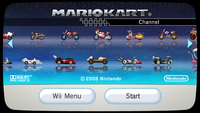
The Mario Kart Channel is a channel specifically made to work with Mario Kart Wii. Once downloaded from the game, this channel can be used to register friends, race ghosts, race friends or random users, enter tournaments and get updates from Nintendo or other players. The 3DS version is only accessed through Mario Kart 7.
Wii U Transfer Tool
Wii U Transfer Tool allows Wii U owners to transfer Wii save data and channels from their Wii to a Wii U console.
WiiWare Channels
- Main article: WiiWare
WiiWare is a feature that was launched for the Wii Shop Channel in 2008, and consisted of smaller-sized games that could be downloaded onto the Wii or SD card memory using Wii Points, which would then appear on the Wii Menu as individual channels. Some Mario-related WiiWare titles include Dr. Mario Online Rx and WarioWare: D.I.Y. Showcase. Some WiiWare titles use Nintendo Wi-Fi connection, allowing the player to play with other Wii players near and far. Others include Mii compatibility, allowing players to play the game as their own Mii created in the Mii Channel. Also, some games allow the player to transfer and use the data from a Nintendo DS game, such as My Pokémon Ranch or WarioWare D.I.Y. Showcase.
Peripherals
Wii Remote
The Wii Remote (also known as the "Wiimote") is the standard game controller for the Wii. It has a rectangular shape, resembling a television remote, making it unique from other consoles' controllers. It consists of several buttons (one behind(![]() )) and a directional pad (
)) and a directional pad (![]() ) as well. The Wii Remote also has a power button(
) as well. The Wii Remote also has a power button(), which can be used as a remote to either turn the Wii console on or off, rather than pressing the power button on the machine itself.
Buttons
- A (
 )
) - B (
 )
) - Home (
 )
) - + (
 )
) - - (
 )
) - 1 (
 )
) - 2 (
 )
) - +Control Pad (
 )
) - Power (
)
Wii Remote Plus
The Wii Remote Plus is an upgraded version of the Wii Remote, which includes the Wii MotionPlus attachment's system incorporated in the controller. The Wii Remote Plus was shown in the Nintendo's conference of September 2010, and is available in white, black, pink, cyan, and red colors. It was released in Europe on November 5, 2010 and in Japan on November 11, 2010.
Mario & Sonic at the Sochi 2014 Olympic Winter Games for the Wii U supports the Wii MotionPlus.
Nunchuk
The Nunchuk is the main attachment to the Wii Remote. Upon buying a Wii, one Wii Remote and one Nunchuk are included. It consists of two buttons(![]() ,
,![]() ) only, along with an analog stick(
) only, along with an analog stick(![]() ). Like the Wii Remote, the Nunchuk also includes motion sensors. It is named as such because of the similarity in appearance to nunchakus when being used together with the Wii Remote. Currently, two Mario games are made that directly make use of the Nunchuk, Super Mario Galaxy and Super Mario Galaxy 2. However, in some games it can be used optionally, changing the controls. An example is New Super Mario Bros. Wii.
). Like the Wii Remote, the Nunchuk also includes motion sensors. It is named as such because of the similarity in appearance to nunchakus when being used together with the Wii Remote. Currently, two Mario games are made that directly make use of the Nunchuk, Super Mario Galaxy and Super Mario Galaxy 2. However, in some games it can be used optionally, changing the controls. An example is New Super Mario Bros. Wii.
Buttons and Stick
- C (
 )
) - Z (
 )
) - Control Stick (
 )
)
Classic Controller
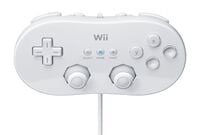
The Classic Controller is an extension or accessory for the Wii's Wii Remote. It is used for playing Classic Games on the Wii. Besides the two analog sticks, the button layout resembles that of the Super Nintendo Entertainment System's controller. The Classic Controller can be used to play Mario classics such as Super Mario 64 and Super Mario World. Even some Wii games, such as Super Smash Bros. Brawl and Mario Kart Wii are compatible as well.
On February 26 2009, Nintendo listed a Classic Controller Pro on its Japanese website, which features the ![]() and
and ![]() buttons as full-fledged shoulder buttons, like the
buttons as full-fledged shoulder buttons, like the ![]() button on the Nintendo Gamecube controller, as well as added controller grips. However, the
button on the Nintendo Gamecube controller, as well as added controller grips. However, the ![]() and
and ![]() buttons are no longer pressure-sensitive, unlike with the original Classic Controller. The size of the same controller is also slightly bigger than its old revision. The Classic Controller Pro was released in Japan on August 1, 2009 in both black and white colors.
buttons are no longer pressure-sensitive, unlike with the original Classic Controller. The size of the same controller is also slightly bigger than its old revision. The Classic Controller Pro was released in Japan on August 1, 2009 in both black and white colors.
Just as the Nintendo GameCube was codenamed Dolphin, and the Wii was codenamed Revolution, the Classic Controller was codenamed Shell[7].
The Wii Remote cannot be used for some Virtual Console console games because it cannot be mapped to emulate an older controller properly.
Buttons and Sticks
- a (
 )
) - b (
 )
) - y (
 )
) - x (
 )
) - +Control Pad (
 )
) - Left Control Stick (
)
- Right Control Stick (
)
- L (
 )
) - R (
 )
) - ZL (
 )
) - ZR (
 )
) - + (
 )
) - - (
 )
) - Home (
 )
) - Control Stick ()
- Control Stick ()
Wii Balance Board
The Wii Balance Board is a controller for the Wii that is used for various games, most prominently in Wii Fit. It, unlike the Nunchuk or Classic Controller, acts as a separate controller, and does not need to be connected to the Wii Remote. The Board is capable of measuring weight, balance, and movement of the player that is using it. The only Mario Game that uses the Wii Balance Board to date is Mario & Sonic at the Olympic Winter Games. The Black Balance Board was released in 2010.
Wii Wheel
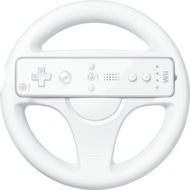
The Wii Wheel (also called the Wii Wiil) is an accessory for the Wii and was designed for Mario Kart Wii, however is not included with the Wii. One Wii Wheel is packaged with Mario Kart Wii, but more can be bought separately. The Wii Wheel is used so players can control the characters much easier in the game. It is a steering wheel seen in cars. It's Nintendo's targeted control scheme.
Nyko, a company that makes Wii accessories makes their own version of the wheel similar to the steering wheel the player can see in the motorcycles in Mario Kart Wii.
Even if the player is not using the wheel and only the Wii Remote held sideways on Mario Kart Wii, it will still show that a wheel is being used. This is only due to the fact that the Wii Remote cannot detect if the wheel is actually attached or not.
Prototypes
The first prototype was made because Nintendo was trying to discover the best position to put the Wii Remote. Since they couldn't decide where the ![]() Button would be used, there was nothing on the back. For the second prototype, they examined real go-kart wheels, and they discovered that they are usually more square than round. The third prototype was the basis for the final Wii Wheel. This prototype had a window for using the Wii Menu, and had a hole for the
Button would be used, there was nothing on the back. For the second prototype, they examined real go-kart wheels, and they discovered that they are usually more square than round. The third prototype was the basis for the final Wii Wheel. This prototype had a window for using the Wii Menu, and had a hole for the ![]() . The fourth prototype had a
. The fourth prototype had a ![]() button in the Wii Wheel itself, so a child’s finger could reach. Finally, the fifth prototype had a two-tone color scheme. A pure white color scheme was eventually decided on to match the Wii Zapper and the Wii Balance Board. Kenichiro Ashida made two Wii Wheels to show at the "Iwata Asks" interview on Mario Kart Wii.
button in the Wii Wheel itself, so a child’s finger could reach. Finally, the fifth prototype had a two-tone color scheme. A pure white color scheme was eventually decided on to match the Wii Zapper and the Wii Balance Board. Kenichiro Ashida made two Wii Wheels to show at the "Iwata Asks" interview on Mario Kart Wii.
Gallery of Undistributed Wheels
Note that even though the Gold Wheel wasn't officially released, it is available for purchase from the Club Nintendo Star Catalogue in Europe for 4000 stars.
Wii Zapper
The Wii Zapper is a rifle-shaped shell used for shooting-related games. The zapper was uniquely made to hold both the Wii Remote and Nunchuck together in a rifle-like position. Nintendo originally sold the Zapper bundled with Link's Crossbow Training although it can be bought separately.
Appearances of Peripherals in the Mario series
WarioWare: Smooth Moves
The Wii Remote (known as the Form Baton in the game) appeared in several microgames in the game, as well as an object in the game's story. The Nunchuk (known as the Balance Stone in the game) appeared in Orbulon's microgames and story.
Super Paper Mario
When the player enters Francis's room in Fort Francis and flips, they can see a large TV and a Wii with a Wii Remote. Also, when the player fights Fracktail, Fracktail starts downloading information about Mario. While he is doing so, his eyes turn into the circle that appears when the Wii Shop Channel is loading from the Wii Menu. Also, if the player in this game got the sleep status froze into a block of ice or eaten up by Francis, they will have to shake the Wiimote to continue on unless they got attacked by an enemy with the sleep status, the heroes will wake up.
Mario Kart Wii
In the cutscene before the select a file screen, Mario and Luigi are using Wii Wheels to race and drive in invisible karts. Peach joins them, with her own Wii Wheel, and their karts become visible shortly afterwards, with their Wii Wheels becoming the karts wheels.
Mario Super Sluggers
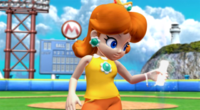
In the opening movie, Princess Daisy, Luigi and Mario were holding Wii remotes before they turned them into bats and a ball.
WarioWare: D.I.Y.
In the intro cutscene of WarioWare: D.I.Y., Dr. Crygor is playing a Wii game, as the console is seen near the TV.
Galleries
System Gallery
Wii's special red edition commemorating the 25th anniversary of the Mario series which comes with New Super Mario Bros. Wii.
Accessory and Controller Gallery
Game Gallery
- Captain Rainbow JAP cover.jpg
- MSOG.PNG
- MP8Box.jpg
- Mariobox-noscale.jpg
- SmG.jpg
Trivia
- The Wii is only one of three Nintendo game systems sold in North America before Japan, the others being the original Nintendo DS and the Wii U.
- This is the only Nintendo console not to receive a Mario Golf game, excluding the SNES and Wii U.
- The Wii Mini is the 3rd home Nintendo console since the SNES and NES to receive a redesign right after its respective successors launched though the NES 101 model launched 2 years after the SNES launched. The N64 received no redesigns of any kind and the GameCube had a small revision which lacked the unused Serial Port 2 (though the cover still remains) and the unpopular Digital AV Out port.
- This is the first home Nintendo console to provide official backwards compatibility with its predecessor.
- Currently, this is the first and only Nintendo console to receive two 3D Mario platformers. All other consoles have only one. Though the N64 was going to receive another one for the N64DD add-on but that was cancelled very early in development due to the poor sales of the add-on and the lack of progress.
- The Wii is currently the easiest Nintendo console to hack.
- This is the third Nintendo home console since the SNES to receive a 2D Super Mario platformer.
References
- ^ http://www.gamespot.com/articles/nintendo-killing-online-support-for-mario-kart-wii-super-smash-bros-brawl-in-may/1100-6417983/
- ^ New Configuration for Wii
- ^ New Wii model's North American promo pack
- ^ http://www.nintendo.com/whatsnew/detail/ONIEEqvK1pbPyTbW2lWO6QnPUiqqvuuI
- ^ http://www.nintendo.co.uk/News/2013/February/New-Wii-mini-console-launching-on-22nd-March-727985.html
- ^ http://www.nintendo.com/whatsnew/detail/a1kK4i_X_mWqfKuJPllLEHmoP_hJnJOq
- ^ Jim Merrick Interview
| Video game consoles and add-ons | |
|---|---|
| Nintendo home consoles | Nintendo Entertainment System/Family Computer (Family BASIC, Family Computer Disk System) • Super Nintendo Entertainment System/Super Famicom (Satellaview, Super Game Boy) • Nintendo 64 (Nintendo 64DD) • Nintendo GameCube (Game Boy Player) • Wii (Virtual Console, WiiWare) • Wii U (Virtual Console) |
| Nintendo handhelds | Game & Watch • Game Boy • Virtual Boy • Game Boy Color • Game Boy Advance • Nintendo DS (Nintendo DSi, DSiWare) • Nintendo 3DS (Virtual Console) |
| Other | MS-DOS • VS. System • Nintendo PlayChoice-10 • Nelsonic Game Watch • Super Mario Bros. Watch • Gamewatch Boy • Philips CD-i • Mini Classics • Nintendo Switch • Triforce • Visteon Dockable Entertainment System • Classics • LodgeNet |

